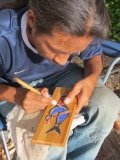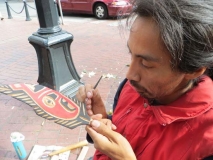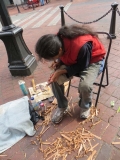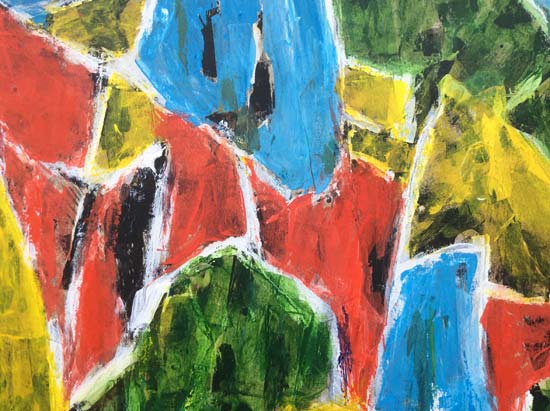Len McKay

By Marylee Stephenson
www.indianartfromtheedge.com — Special to The Post
Len McKay is an Aboriginal artist who truly does his carving while living “on the edge.” He is one of a number of Aboriginal artists who live in the Downtown Eastside of Vancouver and is affiliated with an online art gallery, Indian Art From The Edge. This innovative internet gallery was established to provide a showplace for artists whose housing and income are so modest that they don’t have the space or resources to bring their works to the public in more traditional ways.
Len McKay’s heritage is an Interior Salish person, from the NLa Ka pa mux Nation, centred near Boston Bar. Len is 42 years old and has been carving for about 15 years, with much of that time spent here in Vancouver.
As is so often the case with Aboriginal artists, he learned from a relative, his uncle, who was well known for his own carvings of feathers. The uncle passed on his skills to Len, who now is recognized for his distinctive creations of “story feathers.” These feathers, from eight to 20 inches in length, always have several distinct sections, each with a recognizable character, and each related to the other. A typical feather will be the feather of a raven, with the shaft and smaller segments carefully outlined. Then there will be a figure of a raven’s head, and within its beak may be a large disc. That disc represents the sun, and this is the story “Raven Steals the Light.” The traditional story explains how light came to the earth. The sun and moon had been kept in a box, and Raven, always the Trickster, always the brilliant thinker and fast mover, opened the box, stole the sun, and tossed it into the sky to bring light to all. There may also be the outline of an eagle or a salmon along the edge of the feather, because these creatures are essential elements in the lives of Aboriginal peoples.
Because there isn’t room in Len’s tiny room in the Downtown Eastside for him to do his carving, he must carry all his supplies with him, in a rolling backpack. In it he keeps his small blocks of red cedar, bought piece by piece from a local lumber supply store. There is an old, frayed canvas roll with slots in it, to hold his carving tools, and there is room in the backpack for his polishing wax, brush, and a small range of acrylic paints. Fully equipped, Len McKay then adds a plastic milk crate to his travelling workshop. The crate is his “chair” and the market place for his works. He settles in at one or two locations on the sidewalks of the Downtown Eastside where it is quiet and safe, with a regular flow of workers and tourists. He is never disturbed by police or storeowners because he simply and quietly works and he always leaves the area completely neat at the end of each working day.
As he sits there for many hours a day, most days of the week, Len McKay is friendly, talks with passers-by about his work, and sells pieces as he continues to work on new ones to sell. It is a busy, strenuous life, with sales and survival depending on luck, the ebb and flow of visitors to the city, and the weather. There are even “regulars” who come back now and then to buy a new piece. Not long ago a man from Toronto was in town who had bought a piece from Len when visiting here a year ago. This time he not only bought another feather, he commissioned a special piece as a gift for a friend back home. He wanted Len McKay to carve and paint a large pencil box. The communications about the commission were handled through Len’s Indian Art From The Edge connection, and through this process the piece was packaged and mailed of to Toronto. Len enclosed a complementary small, colourful feather as a thank you for the national exposure of his work.
The working life of a street artist is a tough one, but there are other artists here and there to talk with, and other locals living or working in the area who get to know Len and often stop to talk, share a cup of coffee, and see how his art is very much traditional but always changing.













